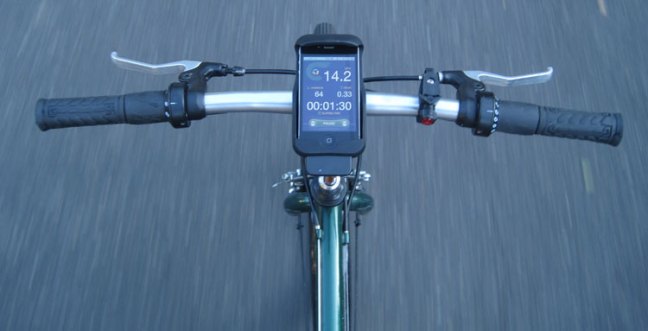
I almost crashed into a baby the first time I rode with the LiveRider iPhone bike computer. Not just a baby, but a woman riding perpendicular to me with a baby carrier on the back of her bike. I was fiddling with the phone trying to see how much wattage I was pumping out at 30mph and didn’t see her in the crosswalk.
My bike squealed to a stop in time, and the baby’s OK. Thanks for asking. But I bring it up not to highlight my own carelessness (which I’m afraid it does anyway), but to illustrate a bigger point: The iPhone wasn’t necessarily meant to live on handlebars.
 The Premise
The Premise
I’m both a bicycle commuter, and a nerd. When I first saw the announcement for LiveRider, a tiny, plug-in accessory that would allow me to use my iPhone as a bike computer, using its own speed and cadence sensors, my head whirred with possibilities.
Maybe it could use GPS data – combined with even more accurate speed and distance readings from its own wheel sensor – to accurately plot every trip I made on a map. Use the phone’s internal gyroscope – or GPS – to recognize the inclines I was climbing and give accurate watt-output readings based on my weight and my bike’s weight. Tap into Google’s brand new bicycle routing and give me turn-by-turn directions that would use bike routes and trails inaccessible to cars to get me safely to the grocery store.
The Letdown
Here comes the stick in the spokes: The LiveRider doesn’t do any of these things. Despite residing on the iPhone, which the computational horsepower, sensors and screen to make a standard bicycle computer look like a Ford Fiesta beside the Space Shuttle Atlantis, LiveRider aspires to do little more than emulate the same functions you can already get from a device the size of a quarter.
Plug a little sensor into the bottom of your phone, slide it into a gigantic rubber mount that zip ties to your handlebars, align a wireless wheel sensor and pedal sensor, and you’re good to go.
It makes a very solid bike computer, to be fair. The LiveRider tracks basics like speed, total distance, and time, but also advanced features like estimated watt output (without factoring slopes, making it quite inaccurate), calories burned, and even a chase feature that lets you set a target pace and watch your progress beside a virtual rider. When you’re done with a ride, you can view a graph of your speed or cadence, then e-mail it off to someone.
The logging feature stands out as the biggest edge the LiveRider has here. No pint-sized cycle computer we know of can show you a full-color graph, let alone allow you to e-mail it off with a touch. But unless you and your cycling nemesis live in different cities, we’re not sure who wants to see bar graphs of how quickly you zoomed around the block. We would rather see tracks plotted on a map – but the LiveRider app remains completely oblivious to location – sorry, no GPS tracking here. You can open a map and see where you are at any given point, though, in case you would rather not pop out of the program to do the same thing on Google Maps.
Using your iPhone as a bike computer also comes with some tradeoffs that will make you question whether you might be better off with a standalone replacement. Sure, the 3.5-inch screen is huge, but you’ll also have a mondo-sized rubber iPhone mount that straps onto the handlebars with cable ties. Text messages will pop over the speedometer, forcing you to close them as you ride. And without any screen protection, you won’t want to use it in the rain – or risk skirting through the mist of those early-morning sprinklers on Portland’s waterfront park.
The Verdict
The LiveRider lets you skip buying a standalone cycle computer and strap an iPhone on the handlebars instead. But for $100, you should think twice before passing on the old-school option. The iPhone is more cumbersome, less readable in sunlight, more sensitive to inclimate weather, and if you already have yours in a case, you’ll have to take it in and out every time you ride. It also lacks some features that many cyclocomputers in this price range have, like temperature, altitude, estimated time of arrival, and the ability to pair with a heart rate monitor. Serious cyclists will get a kick out of the awfully slick graphic user interface, ride stats, and the chase bike option, but we have our fingers and toes crossed that future software updates will offer even more compelling features that truly tap all the resources the iPhone offers.
Highs:
- Accurate RPM, speed, time readings
- Secure, easy-to-use mount
- Wireless sensor
- Easy to log, view and share speed and RPM data
Lows:
- Doesn’t leverage iPhone’s full potential
- No GPS tracking, navigation, altitude, inclination, heart rate
- Wattage doesn’t factor hills
- Dorky, oversized iPhone mount
 The Premise
The Premise


